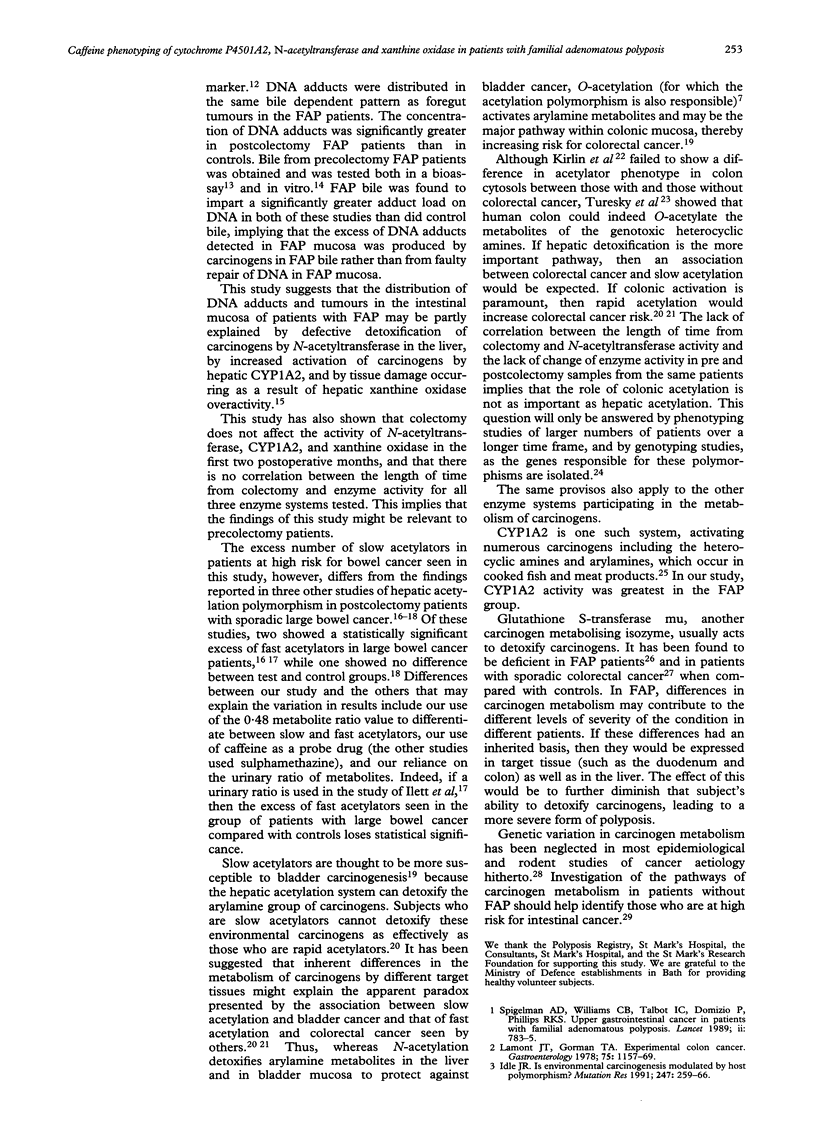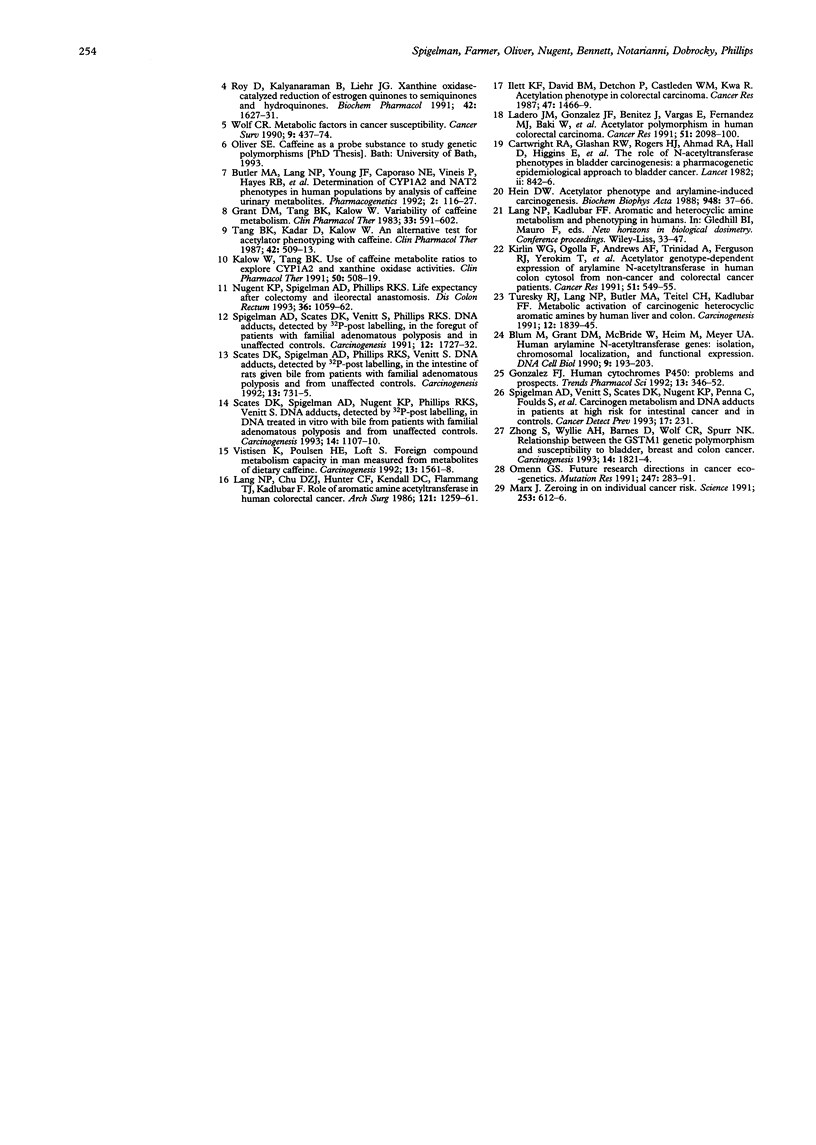Abstract
Patients with familial adenomatous polyposis (FAP) and age and sex matched controls were tested for cytochrome P4501A2 (CYP1A2), N-acetyltransferase, and xanthine oxidase activities using caffeine urinary metabolites as a discriminator. FAP patients showed significant underactivity of N-acetyltransferase (which inactivates some carcinogens) and significant overactivity of CYP1A2 (which activates some carcinogens). Xanthine oxidase activity, which can generate free radicals and cause cellular damage, was significantly increased in the FAP patients. All but one of the FAP patients had undergone colectomy. A separate group of six patients was therefore assessed before and at an average time of eight weeks after colectomy. No effect on enzyme activity was seen. The differences in enzyme activities detected in this study could produce an excess of active carcinogenic metabolites in the bile of FAP patients and contribute to the high risk for intestinal cancer in FAP.
Full text
PDF



Selected References
These references are in PubMed. This may not be the complete list of references from this article.
- Blum M., Grant D. M., McBride W., Heim M., Meyer U. A. Human arylamine N-acetyltransferase genes: isolation, chromosomal localization, and functional expression. DNA Cell Biol. 1990 Apr;9(3):193–203. doi: 10.1089/dna.1990.9.193. [DOI] [PubMed] [Google Scholar]
- Butler M. A., Lang N. P., Young J. F., Caporaso N. E., Vineis P., Hayes R. B., Teitel C. H., Massengill J. P., Lawsen M. F., Kadlubar F. F. Determination of CYP1A2 and NAT2 phenotypes in human populations by analysis of caffeine urinary metabolites. Pharmacogenetics. 1992 Jun;2(3):116–127. doi: 10.1097/00008571-199206000-00003. [DOI] [PubMed] [Google Scholar]
- Cartwright R. A., Glashan R. W., Rogers H. J., Ahmad R. A., Barham-Hall D., Higgins E., Kahn M. A. Role of N-acetyltransferase phenotypes in bladder carcinogenesis: a pharmacogenetic epidemiological approach to bladder cancer. Lancet. 1982 Oct 16;2(8303):842–845. doi: 10.1016/s0140-6736(82)90810-8. [DOI] [PubMed] [Google Scholar]
- Gonzalez F. J. Human cytochromes P450: problems and prospects. Trends Pharmacol Sci. 1992 Sep;13(9):346–352. doi: 10.1016/0165-6147(92)90107-h. [DOI] [PubMed] [Google Scholar]
- Grant D. M., Tang B. K., Kalow W. Variability in caffeine metabolism. Clin Pharmacol Ther. 1983 May;33(5):591–602. doi: 10.1038/clpt.1983.80. [DOI] [PubMed] [Google Scholar]
- Hein D. W. Acetylator genotype and arylamine-induced carcinogenesis. Biochim Biophys Acta. 1988 Aug 3;948(1):37–66. doi: 10.1016/0304-419x(88)90004-2. [DOI] [PubMed] [Google Scholar]
- Idle J. R. Is environmental carcinogenesis modulated by host polymorphism? Mutat Res. 1991 Apr;247(2):259–266. doi: 10.1016/0027-5107(91)90021-f. [DOI] [PubMed] [Google Scholar]
- Ilett K. F., David B. M., Detchon P., Castleden W. M., Kwa R. Acetylation phenotype in colorectal carcinoma. Cancer Res. 1987 Mar 1;47(5):1466–1469. [PubMed] [Google Scholar]
- Kalow W., Tang B. K. Use of caffeine metabolite ratios to explore CYP1A2 and xanthine oxidase activities. Clin Pharmacol Ther. 1991 Nov;50(5 Pt 1):508–519. doi: 10.1038/clpt.1991.176. [DOI] [PubMed] [Google Scholar]
- Kirlin W. G., Ogolla F., Andrews A. F., Trinidad A., Ferguson R. J., Yerokun T., Mpezo M., Hein D. W. Acetylator genotype-dependent expression of arylamine N-acetyltransferase in human colon cytosol from non-cancer and colorectal cancer patients. Cancer Res. 1991 Jan 15;51(2):549–555. [PubMed] [Google Scholar]
- LaMont J. T., O'Gorman T. A. Experimental colon cancer. Gastroenterology. 1978 Dec;75(6):1157–1169. [PubMed] [Google Scholar]
- Ladero J. M., González J. F., Benítez J., Vargas E., Fernández M. J., Baki W., Diaz-Rubio M. Acetylator polymorphism in human colorectal carcinoma. Cancer Res. 1991 Apr 15;51(8):2098–2100. [PubMed] [Google Scholar]
- Lang N. P., Chu D. Z., Hunter C. F., Kendall D. C., Flammang T. J., Kadlubar F. F. Role of aromatic amine acetyltransferase in human colorectal cancer. Arch Surg. 1986 Nov;121(11):1259–1261. doi: 10.1001/archsurg.121.11.1259. [DOI] [PubMed] [Google Scholar]
- Marx J. Zeroing in on individual cancer risk. Science. 1991 Aug 9;253(5020):612–616. doi: 10.1126/science.1651561. [DOI] [PubMed] [Google Scholar]
- Nugent K. P., Spigelman A. D., Phillips R. K. Life expectancy after colectomy and ileorectal anastomosis for familial adenomatous polyposis. Dis Colon Rectum. 1993 Nov;36(11):1059–1062. doi: 10.1007/BF02047300. [DOI] [PubMed] [Google Scholar]
- Omenn G. S. Future research directions in cancer ecogenetics. Mutat Res. 1991 Apr;247(2):283–291. doi: 10.1016/0027-5107(91)90023-h. [DOI] [PubMed] [Google Scholar]
- Roy D., Kalyanaraman B., Liehr J. G. Xanthine oxidase-catalyzed reduction of estrogen quinones to semiquinones and hydroquinones. Biochem Pharmacol. 1991 Sep 27;42(8):1627–1631. doi: 10.1016/0006-2952(91)90433-6. [DOI] [PubMed] [Google Scholar]
- Scates D. K., Spigelman A. D., Nugent K. P., Phillips R. K., Venitt S. DNA adducts, detected by 32P-postlabelling, in DNA treated in vitro with bile from patients with familial adenomatous polyposis and from unaffected controls. Carcinogenesis. 1993 Jun;14(6):1107–1110. doi: 10.1093/carcin/14.6.1107. [DOI] [PubMed] [Google Scholar]
- Scates D. K., Spigelman A. D., Phillips R. K., Venitt S. DNA adducts detected by 32P-postlabelling, in the intestine of rats given bile from patients with familial adenomatous polyposis and from unaffected controls. Carcinogenesis. 1992 Apr;13(4):731–735. doi: 10.1093/carcin/13.4.731. [DOI] [PubMed] [Google Scholar]
- Spigelman A. D., Scates D. K., Venitt S., Phillips R. K. DNA adducts, detected by 32P-postlabelling, in the foregut of patients with familial adenomatous polyposis and in unaffected controls. Carcinogenesis. 1991 Sep;12(9):1727–1732. doi: 10.1093/carcin/12.9.1727. [DOI] [PubMed] [Google Scholar]
- Spigelman A. D., Williams C. B., Talbot I. C., Domizio P., Phillips R. K. Upper gastrointestinal cancer in patients with familial adenomatous polyposis. Lancet. 1989 Sep 30;2(8666):783–785. doi: 10.1016/s0140-6736(89)90840-4. [DOI] [PubMed] [Google Scholar]
- Tang B. K., Kadar D., Kalow W. An alternative test for acetylator phenotyping with caffeine. Clin Pharmacol Ther. 1987 Nov;42(5):509–513. doi: 10.1038/clpt.1987.189. [DOI] [PubMed] [Google Scholar]
- Turesky R. J., Lang N. P., Butler M. A., Teitel C. H., Kadlubar F. F. Metabolic activation of carcinogenic heterocyclic aromatic amines by human liver and colon. Carcinogenesis. 1991 Oct;12(10):1839–1845. doi: 10.1093/carcin/12.10.1839. [DOI] [PubMed] [Google Scholar]
- Vistisen K., Poulsen H. E., Loft S. Foreign compound metabolism capacity in man measured from metabolites of dietary caffeine. Carcinogenesis. 1992 Sep;13(9):1561–1568. doi: 10.1093/carcin/13.9.1561. [DOI] [PubMed] [Google Scholar]
- Wolf C. R. Metabolic factors in cancer susceptibility. Cancer Surv. 1990;9(3):437–474. [PubMed] [Google Scholar]
- Zhong S., Wyllie A. H., Barnes D., Wolf C. R., Spurr N. K. Relationship between the GSTM1 genetic polymorphism and susceptibility to bladder, breast and colon cancer. Carcinogenesis. 1993 Sep;14(9):1821–1824. doi: 10.1093/carcin/14.9.1821. [DOI] [PubMed] [Google Scholar]


